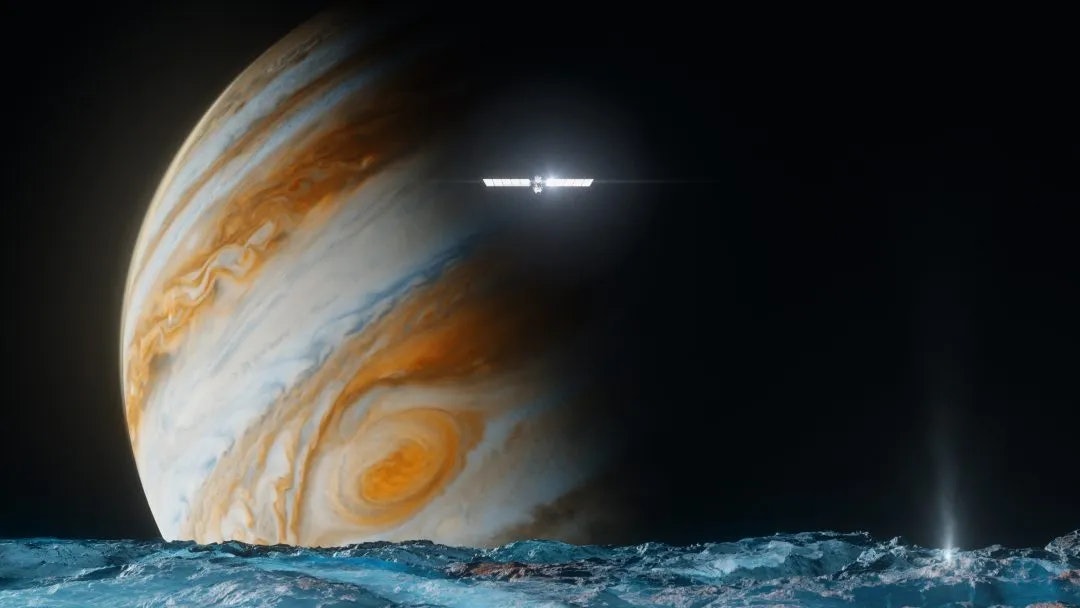
NASA’s Europa Clipper is now soaring towards Jupiter to look for an environment that could support extraterrestrial life.
The spacecraft is the largest NASA has ever developed for a planetary mission. When its solar arrays are fully deployed, Clipper will span more than 100 feet.
Europa Clipper launched successfully on Monday afternoon from the space agency’s Kennedy Space Center in Cape Canaveral, Florida. When a SpaceX Falcon Heavy rocket lofted the mission into space, astronomers started a seven-year countdown. In 2031, Europa Clipper will rendezvous for the first time with the moon Europa.

In the dark, deep pits of this Moon-sized world, the environment might be just right to harbor life. When NASA’s Voyager 2 first photographed Europa 50 years ago, and as other spacecraft like Galileo, New Horizons, and Juno have since then peeked at its surface, astronomers began to suspect that Europa’s 15-mile thick outer crust of ice was hiding an ocean. An eclectic mix of circumstances in the outer Solar System might resemble the hydrothermal vent environment at the bottom of Earth’s oceans where biologists suspect life first arose on our planet.
At 12:06 p.m. Eastern, the Falcon Heavy cleared the launchpad. A minute later, it went supersonic. It survived the roughest phase of ascension, called Max q, when dynamic pressures cause the rocket to experience maximum mechanical stress. The Falcon Heavy’s boosters, which previously helped launch NASA’s Psyche mission, successfully released four minutes after launch. Two minutes later, the rocket had completed its job, leaving Europa Clipper to complete the rest of the journey. Clipper then began its first maneuver, a roughly three-minute burn, to begin setting up its trajectory towards Jupiter.
Clipper will build upon what’s known about Europa’s ice. Previous studies have found signs that there is a subsurface ocean that helps the crust to regenerate. If it exists, the ocean covers Europa’s entire body. It’s a dark place, definitely blocked from whatever sunlight reaches Jupiter’s realm.
“We believe there are some unusual features down here that are caused by Jupiter. Jupiter is huge. You can fit a thousand Earths inside of it. On top of that, the orbit of Europa is not quite circular. So when it gets close to Jupiter, it gets kind of squashed. When it gets further away, it releases this mechanical energy into thermal energy,” Bonnie Buratti, deputy project scientist of Europa Clipper, said in a NASA broadcast played before the spacecraft’s launch.
The heat could come out as thermal vents, releasing energy and chemicals to create “an ideal region for a habitable environment.”
Most life on Earth needs sunlight — but not all. Abyssal and Hadal regions at the depths of Earth’s oceans are also dark. There, heat is generated from the ground below the water.
Clipper will search for answers by performing almost 50 close flybys of Europa’s surface, intricate “clips” that allow it to collect precious clues while surviving Jupiter’s dangerous radiation environment.
NASA will shape Europa Clipper’s route by sending it on gravitational flybys of Mars and Earth in the next few years. If all goes according to plan, in 2030, Clipper will first encounter Jupiter, and undergoes a lengthy maneuver to insert itself into the gas giant’s orbit. Clipper will then use the gravity of other Jovian moons to tweak its path through space and to shrink its orbit down to its ideal track.
Eventually, Europa Clipper’s work could prove the universe is a less lonely place than we currently think.







